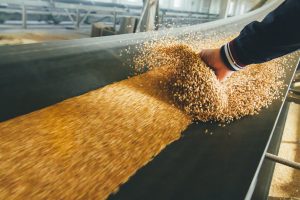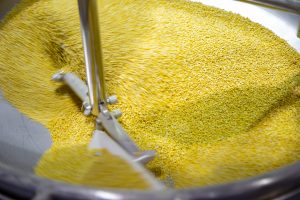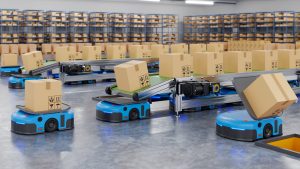AirSweep, DAZIC & AcoustiClean: Integrated Solutions for Bulk Product Handling
Comments Off on AirSweep, DAZIC & AcoustiClean: Integrated Solutions for Bulk Product Handling
The production process involves several interconnected steps. Any problems in one stage often create a domino effect, causing more delays and incurring more costs. Control Concepts, Inc. offers proven bulk product handling technology that improves plant efficiency and productivity that can be used individually or integrated to reduce downtime, material waste, and safety hazards.
AirSweep for on-demand material flow
Poor material flow can lead to several problems that can affect a plant’s productivity and a company’s bottom line.
- Lower productivity. When the flow stops, so does the entire production line.
- Smaller vessel capacity. Stagnant material can reduce the amount of material that can flow in and out of the vessel.
- Material spoilage and waste. Inconsistent material flow can lead to stagnant and spoiled material or inconsistent batches that need to be thrown away.
- Worker safety hazards. Workers have to manually clear material from vessels and may be unnecessarily exposed to hazardous materials.
Prevent these problems with AirSweep. It releases powerful air pulses that push material into the flow stream, leading to steady, on-demand flow.
AirSweep is proven effective for materials with challenging flow properties, such as powders that tend to clump or moist and sticky mixes that stick to vessel walls.
Many customers say that AirSweep was the only flow aid that worked for them—they tried fluidizers, vibrators, and air cannons, but still had to manually clear material. But once they installed AirSweep, they never had to worry about material blocks again.
DAZIC for preventing material pile-up
Many processes involve moving tons of material at a time. If any of the equipment malfunctions, that could mean massive spillage—and a mountain of problems.
- Days of downtime. Equipment must be turned off until the material pile-up is cleared. Workers have to manually clear the material, or sit around and wait until production resumes.
- Material waste. In some cases, the material is too contaminated to reuse and must be thrown away.
- Safety hazards. Workers may be exposed to toxic or hazardous materials.
DAZIC zero speed switches can help prevent material pileups and detect machine failure. They are attached to rotating shafts and send an alarm when there is an abnormal change in rotation speed.
DAZIC speed switches are affordable, efficient, and durable. Many clients are still using the switches they installed over a decade ago, and have never had any incidents of material pile-ups.
The speed switches can be installed on any equipment with a rotating shaft, such as rotary valves, bucket elevators, belt and screw conveyors, saw blades, and drive motors.
AcoustiClean for clearing powder build-up
Powder build-up can clog pipes and affect equipment efficiency, and even create potentially flammable environments. Manual cleaning takes too long, and may even be impractical or impossible for some plant set-ups.
AcoustiClean sonic horns can clear powder build-up quickly and easily—and will never damage even fragile equipment. It releases sound vibrations that can disperse particles even in blind spots that mechanical blowers and rapping systems miss.
Integrated solutions for maximum plant efficiency
AirSweep, DAZIC, and AcoustiClean can work together to control material flow, clean residue, and prevent build-up—as seen in this diagram of a co-gen plant.
Find the right bulk product handling system for your needs
Control Concepts, Inc. can customize a bulk product handling system for your particular material, vessel, and process. Contact us so we can discuss your needs and provide you with a customized diagram.
3 Types of Material Blocks that Slow Down Production
Comments Off on 3 Types of Material Blocks that Slow Down Production
In the manufacturing process, production speed and product quality heavily depend on reliable material flow. That means materials flow smoothly, in a first in/first out pattern. However, bulk materials have a tendency to clump together, cling to vessel walls, or form large material blocks that restrict the discharge outlets. Flow can slow down, or even stop completely. Here are the most common types of material blocks, and the only flow aid you need to prevent them.
Bridging / arching
As the name implies, materials form a large bridge or arch right above the vessel outlet. This happens when the particles interlock and bond together, and need an external force to break it up and restore the flow.
There are two types of bridging or arching:
- Interlocking arch. The particles mechanically interlock, like pieces of a jigsaw puzzle.
- Cohesive arch. The particles are bonded together because of moisture, temperature, or the concentration of fines.
The strength of the bridge or the arch depends on the material’s inherent cohesive strength and the internal friction of the particles. For example, very fine powders like flour may respond to gentle aeration. However, cocoa powder or titanium dioxide—which has a tendency to clump and aggregate—will need more powerful, concentrated air pulses.
Ratholing
Ratholing occurs when materials accumulate along the vessel walls, leaving only a small flow channel right above the outlet. This creates two problems: the flow slows down, and stagnant material stays in the vessel. Without first in/first out flow, manufacturers run the risk of spoilage and contamination.
Furthermore, if the material has cohesive properties, it will cake and agglomerate instead of flowing out of the vessel. Eventually, the channel closes up and the flow completely stops.
Particle segregation
Granular materials can segregate because of differences in size, shape, and density. This can occur during crushing and grinding, transportation, storage, and mixing.
Segregation is especially critical in the chemical, pharmaceutical, and food industries when materials must be mixed in exact proportions to protect product integrity. For example, a supplement needs a precise balance of vitamins and minerals that is declared on the nutrition label—otherwise, the company could be slapped with a fine and be forced to recall entire batches that don’t meet the specs.
The “perfect” material flow
The gold standard of material flow is mass flow, which has the following characteristics:
- Steady, uniform flow with a consistent bulk density
- First in / first out – no stagnant material
- Controlled discharge rates with no issues of stopping or flooding
AirSweep: achieve reliable material flow
AirSweep is a pneumatic flow aid. It uses powerful, 360-degree air pulses to break apart material blocks and sweep material back into the flow stream.
And when material flows, so do productivity and profits.
- Reduce downtime from manually clearing material blocks or flushing vessels between product batches
- Improve product consistency and quality by preventing stagnant material and segregation
- Avoid material waste from throwing away contaminated material or inconsistent batches
AirSweep also lowers maintenance costs, because it uses less energy and does not damage vessels like other flow aids such as vibrators and fluidizers.
Get a customized proposal for your process
There is no “one size fits all” setup to prevent material blocks. We can customize an AirSweep system where nozzles are positioned at the right place, and release the right sequence of pulses, to move material efficiently.
Contact us to find out more about how AirSweep works, and how it can help improve your process.
Why is AirSweep Effective for Mined Materials?
Comments Off on Why is AirSweep Effective for Mined Materials?
Mined materials are one of the most critical components of the manufacturing industry. They are used to make thousands of commodities, from automobiles to electronics, and even medicines and household cleaning products. The mobile phone alone uses 42 different minerals—not including what is used for its packaging (paper and plastic need minerals, too!)
You can mine it… but can’t you move it?
However, mined materials have poor flow properties that can pose challenges during storage, processing, and packaging.
For example, hydrated lime—one of the most common components of cement production—is sluggish and has a tendency to pack, bridge, or rathole.
Wet materials such as damp sand or Diatomaceous earth can cling to vessel walls and plug the outlets.
Minerals with irregular particles can also segregate if they have a different hardness, grade, or size. Even after they are carefully screened and processed to a more consistent form, the particles can still interlock.
The best flow aid for mined materials
It’s important to choose a flow aid that can handle mined materials’ unique characteristics. Fluidizers can only activate powders that respond to light aeration. Vibrators can cause some minerals to become more compact. Air cannons still leave residue on vessel walls, and the air tends to “channel” through holes in the material, greatly diminishing effectiveness.
That’s why many companies switched to AirSweep. The powerful air pulses can improve the flow of any mined material—from fine powders to heavy rocks.
AirSweep increases productivity
A leading processor of industrial minerals handles more than 120,000 tons of material every year. However, their biggest challenge was transferring the processed material. It took over an hour to fill one supersack, and workers still had to hammer the vessels.
AirSweep cut that filling time from one hour to two minutes—a 3000% increase in productivity. Production volume increased to the point that an additional forklift driver was hired to keep up with the output.
AirSweep saves money
A cement company had issues with shale clogging the silos. They tried air knockers and vibrators, but workers still had to manually clear the vessels—losing $12,000 per hour of downtime.
AirSweep was the only flow aid that cleared all material build-up, and it used half the energy of air knockers. Since the cost per KWH was very high in their country, the electricity savings alone brought a great return on investment.
The proof is in the flow
AirSweep is used in thousands of plants around the world and has been proven effective for even the most problematic mined materials. Watch this material flow test on powdered hydrated lime.
AirSweep in the mined materials industry
Visit this page to find more case studies and videos on how AirSweep is being used to activate mined materials or contact us for more information and a customized quote.
5 Top Technologies for Automated Bulk Material Handling
Comments Off on 5 Top Technologies for Automated Bulk Material Handling
Bulk material handling is an essential part of any industrial or manufacturing process. Raw materials must be delivered to a factory, unloaded into storage facilities, and then poured into silos, hoppers, and other vessels for processing. Automated bulk material handling can make these processes more efficient. Here are some of the latest technology that can help move material in a faster, safer, and even cheaper way.
Automated guided vehicles (AGVs)
AGVs are self-propelled vehicles that can move large volumes of material along a defined pathway, like receiving to the warehouse or straight to the production lines. They can replace manually-operated forklifts and carts, or be used in areas that can’t be reached by conveyor systems.
The AGVs are guided by software and sensors. They can be programmed to run at specific times or stages during the production cycle so that materials are delivered whenever they are needed, without interruption.
There are many different kinds of AGVS: forklifts, carts, towing vehicles, and unit load handlers for small items.
Automated Storage & Retrieval System (AS/RS)
AS/RS systems handle, store, and retrieve materials in warehouses and other storage facilities. This can include automated carousels, vertical lifts, shuttles, and other machines that can lift heavy loads.
AS/RS can maximize storage space, reduce damage to products, and improve inventory control. Since fewer people are required to move items, companies can also tighten security and limit who can access the warehouse and other storage areas.
Warehouse Tracking
Warehouses need to follow a first in/first out system so that materials don’t spoil. However, new shipments are usually placed on top of the stack, so it’s hard to track where the oldest materials are.
Smart warehouse technology systems use coordinated routing, tracking, and control systems to show employees which box or bag must be used next. This includes a consolidated Warehouse Management System (WMS), automated picking tools, and automated inventory control platforms.
Aside from preventing spoilage, these new bulk material handling technologies reduce the cost of manpower and improve demand forecasting.
Machine Monitoring
Machine monitoring prevents shutdowns caused by machine failure.
Sensors alert operators of any problems in mixers, grinders, or conveyors. For example, the material got wet and stuck to the machine, or the scales malfunctioned and overloaded the vessel.
Sensors can also detect vibrations, unbalanced loads, and temperatures of the bearings. While it won’t be able to diagnose the problem, automated monitoring allows operators to troubleshoot and do preventive maintenance.
The sensors are actually required in industries that work with fine powders or other flammable materials that could be ignited by excessive friction in machine parts.
Some sensors have been around for more than a decade, and are proven effective in preventing plant accidents. DAZIC zero speed switches can be attached to conveyors, bucket elevators, and other equipment in a material conveyor system. It detects abnormal changes in speed that could lead to material pileup.
Material flow aids
Poor or irregular material flow slows down production and compromises batch consistency. Stagnant material can also lower the storage capacity of silos and hoppers and may deteriorate and spoil.
Traditionally, workers would have to manually clear material with hammers and pick-axes. However, modern material flow aids like AirSweep can prevent material blocks from occurring.
AirSweep releases powerful air pulses that move stagnant material back into the flow stream. It can be used during processing to ensure first-in / first-out flow, or after processing to flush the vessels clean before the next batch.
Here’s how the AirSweep system allows automated bulk material handling:
Contact us to find out more about AirSweep and other products that can improve your bulk material handling.





